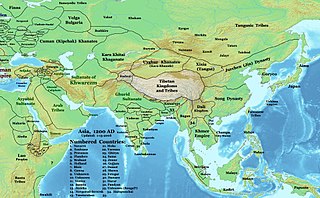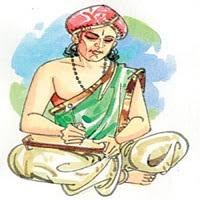
Telugu is a Dravidian language spoken by Telugu people predominantly living in the Indian states of Andhra Pradesh and Telangana, where it is also the official language. Telugu is also an official language in West Bengal, Yanam district of Puducherry and a linguistic minority in the states of Odisha, Karnataka, Tamil Nadu, Kerala, Punjab, Chhattisgarh, Maharashtra and Andaman and Nicobar Islands. It is one among the six languages designated as a classical language of India in the country. Telugu was also referred as Andhramu (ఆంధ్రము)
Kavi is a term for poet or poem in some Indian languages.
Indian literature refers to the literature produced on the Indian subcontinent until 1947 and in the Republic of India thereafter. The Republic of India has 22 officially recognised languages.

Sanskrit literature broadly comprises texts composed in the earliest attested descendant of the Proto-Indo-Aryan language known as Vedic Sanskrit and later on in the language formally defined by Pāṇini usually called Classical Sanskrit.

Telugu literature is the body of works written in the Telugu language. It consists of poems, short stories, novels, plays, and song lyrics, among others. There is some indication that Telugu literature dates at least to the middle of the first millennium, the first extant works are from the 11th century when the Mahabharata was first translated to Telugu from Sanskrit by Nannaya. The language experienced a golden age under the patronage of the Vijayanagara king-poet Krishnadevaraya.
Dhurjati was a Telugu poet in the court of the king Krishnadevaraya and was one of the astadiggajalu there.

The languages of India are divided into various language families, of which the Indo-Aryan and the Dravidian languages are the most widely spoken, together known as Indic languages. There are also many languages belonging to unrelated language families such as Austroasiatic and Sino-Tibetan, spoken by smaller groups. Linguistic records begin with the appearance of the Gujarati from about the 3rd century BCE.
Charles Philip Brown was a British official of the East India Company. He worked in what is now Andhra Pradesh, and became an important scholarly figure in Telugu language literature.

Vijayanagara literature was produced in the Vijayanagara Empire during a golden age of literature in South India in general. The rulers patronised Kannada, Telugu, Sanskrit and Tamil scholars who wrote in the Jain, Virashaiva and Vaishnava traditions. The period produced hundreds of works on all aspects of Indian culture, religion, biographies, Prabhandas (stories), music, grammar, poetics and medicine. An attempt is made in this section to list the various poets and saints and their most famous works.

Hoysala literature is the large body of literature in the Kannada and Sanskrit languages produced by the Hoysala Empire (1025–1343) in what is now southern India. The empire was established by Nripa Kama II, came into political prominence during the rule of King Vishnuvardhana (1108–1152), and declined gradually after its defeat by the Khalji dynasty invaders in 1311.
Mallampalli Sarabheswara Sarma, popularly known as 'Sarabhayya', was a well-known Indian poet, critic, translator and exponent of classical literature.

Vijayanagara literature in Kannada is the body of literature composed in the Kannada language of South India during the ascendancy of the Vijayanagara Empire which lasted from the 14th through the 16th century. The Vijayanagara empire was established in 1336 by Harihara I and his brother Bukka Raya I. Although it lasted until 1664, its power declined after a major military defeat by the Shahi Sultanates in the battle of Talikota in 1565. The empire is named after its capital city Vijayanagara, whose ruins surround modern Hampi, now a World Heritage Site in Karnataka.
Champu or Chapu-Kavya is a genre of literary composition in Indian literature. The word 'Champu' means a combination of poetry and prose. A champu-kavya consists of a mixture of prose (Gadya-Kavya) and poetry passages (Padya-Kavya), with verses interspersed among prose sections.
Chilakamarti Lakshmi Narasimham was an Indian playwright, novelist and author of short stories, who wrote in the Telugu language. He was a romantic and a social reformer in the tradition founded by Veeresalingam. His best-known plays are probably Gayopakhyanam (1909) and Ganapati (1920).

Sumati Shatakam is one of the most famous Telugu Shatakam. It is a neeti (moral) Shatakam.

Kasula Purushottama Kavi was a Telugu poet who lived during the late 18th century. His parents were Kasula Appalaraju and Ramanamma. He hailed from the Diviseema area of Krishna District, Andhra Pradesh. He was a court poet of the then-Raja of Challapalli, Yarlagadda Ankineedu Prasad I of the Challapalli Samasthanam and possibly of his father as well. Purushottama Kavi is recognized for composing literary works in Telugu consisting of one hundred poetic stanzas, known as satakams.

Andhra Vishnu, better known as Srikakula Mahavishnu statue, was set up in Andhra in a pre-existing older temple. The previous deistic form worshiped in the temple is unknown.
Rambhatla Lakshminarayana Sastry(b: 9 December 1908 - d: 19 November 1995) was an eminent Indian teacher, author, playwright, translator, commentator and speaker in Telugu & Sanskrit languages. Sastry's life and notable works have been documented and covered in Telugu University under Luminaries of 20th Century.

Ilapavuluri Panduranga Rao was an Indian scholar, poet, writer, linguist and orator of Telugu descent.
Bellamkonda Ramaraya Kavindrulu (1875–1914) was an Indian poet, author, yogi, Sanskrit scholar and a philosopher.










